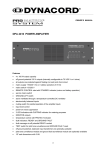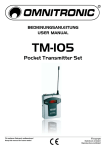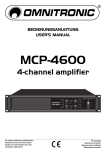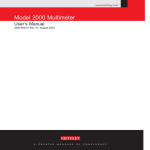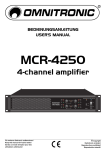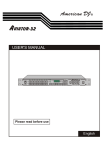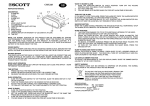Download Dynacord Car Amplifier DPA 4120 User's Manual
Transcript
POWER AMPLIFIER DPA 4120 / DPA 4140 OWNER'S MANUAL DPA 4140 40 0 WATT S POWER AMPL IF IER CLIP T EST 0dB - 13dB READY STANDBY GROUND FAULT PROT ECT Performance Features Power amplifier with 200 W or 400 W output power according to the IEC 283-3 standard within a 19“ - cabinet (3 HU) providing the following functions: • • • • • • • • • • • • • • • • supported are 115/230V AC mains as well as 24V DC emergency power source power amplifiers DPA 4120 providing 200 W or DPA 4140 providing 400 W output power, idling and short-circuit protection output transformer for balanced, floating 100 V speaker networks of optionally 70 V, 50 V or 4 ohms for low-impedance operation optional input modules: standard operation INPUT MODULE with level control, electronically balanced input and MONITOR output with optional transformer or REMOTE MODULE for controlling and monitoring the PROMATRIX system, electronic level controls, electronically balanced input and MONITOR output with optional transformer integrated stand-by power supply mains POWER ON/OFF switch ground lift switch remotely controllable mains and battery operation with initial current inrush limiter power-on switching noise suppression status-LED indicators for operation (READY), STANDBY, thermal overload (PROTECT) and occurrence of GROUND FAULT conditions at the power output fault message according to the IEC 849 standard TEST button to switch between system and average operation, respectively a RESET button to restart after the occurrence of ground fault conditions LED level meter instrument with a display range of -13 dB to 0 dB and CLIP integrated relays for single call and obligatory reception active, temperature controlled ventilation pilot tone and ground fault surveillance module according to the DIN/VDE 0800 standard (optional) 23 24 Indicators, controls and connections 1 2 DPA 4140 4 0 0 WATT S PO WE R AM P L IFI ER TES T 3 R EAD Y STAN DBY G RO UN D FAUL T 4 PR OTE CT C LIP 0dB -1 3 d B 5 8 A 9 10 A 11 T4A FOR 230V T8A FOR 115V P OWER 12 7 6 13 A B NOUSER SERVICEABLE PARTS INSIDE. REFERSERVICING TO QUALIFIED SERVICE PERSONNEL. VOLTAGE SELECTOR 115V 230V DPA 4140 121629 AC MAI NS I NPUT 115V / 230V AC 50-60 Hz INPUT 14 THRU 15 MADE IN GERMANY CAUTION: FOR CONTINUED PROTECTION AGAINST RISK OF FIRE REPLACE WITH SAME TYPE AND VALUE FUSE INDICAT ED. ATTENTION: REMPLACER PAR UN FUSIBLE DE MEME TYPE COMME INDIQUE. B C AUTION A ADDRESS RISK OF ELECTRICSHOCK DO NOT OPEN 3 2 1 OUT PUT VO LTAG E 0 WARNING: TO REDUCE THE RISK OF FIRE ORELECTRIC SHOCK, CIRCUIT T O CHASSIS SWITCH A 9 A VO R ÖF F NEN DES G ER ÄTES NET Z ST ECKER Z IEHEN 19 10 T4A FOR 230V T8A FOR 115V 1 2 3 4 5 18 11 POWER 16 POWER OUTPUT GROUNDED UNGROUNDED 20 10 REMOTE CONTROL AVIS: RISQUE DE CHOCELECTRIQUE. NE PAS OUVRIR. + 7 8 9 LEVEL DO NOT EXPOSE THIS APPLIANCE TO RAINOR MOISTURE. DC I NPUT 24V 4 5 6 12 90225 17 B 15 A VOLTAGE SELECTOR 115V 230V NO USER SERVICEABLE PARTS INSIDE. REFER SERVICING TO QUALIFIED SERVICE PERSONNEL. B INPUT DPA 4140 14 121629 AC MAINS INPUT 115V /230V AC 50-60 Hz ADDRESS M ADE IN GERMANY A CAUTION: FORCONTINUED PROT ECTIONAGAINST RISK OF FIRE REPLACE WITHSAME TYPE AND VALUE F USE INDICATED. ATTENTION: REMPLACERPARUN FUSIBLE DE MEME TYPE COMME INDIQUE. B B CA UTION AD DRESS RISK OF ELECTRIC SHOCK DO NOT OPEN THRU IN O UT PUT VO LTAGE WARNING: TO REDUCE THE RISK OF FIRE OR ELECTRICSHOCK, REMOTE CONTROL DONOT EXPOSE THIS APPLIANCE TO RAIN ORMOISTURE. 22 AVIS: RISQUE DE CHOC ELECTRIQUE. NE PAS OUVRIR. DC INPUT 24V + 20 1 2 3 4 5 6 7 8 9 CIRCUIT TO CHASSIS SWITCH GROUNDED UNGROUNDED 19 21 A P OWER OUTPUT OUT 23 STATUS VO R Ö FF NEN DES G ERÄTES NET Z STECKER Z IEHEN 18 1 2 3 4 5 17 level meter instrument CLIP indicator Test and Reset button TEST STANDBY indicator Fault indicator PROTECT Fault indicator GROUND FAULT Mode indicator READY Ventilation louvres Mains power switch POWER 10 11 12 13 14 15 16 17 18 25 90222 B Mains power connector AC MAINS INPUT Mains fuse FUSE Mains VOLTAGE SELECTOR Input LEVEL control INPUT socket THRU socket REMOTE CONTROL connector POWER OUTPUT Ventilation louvres 19 20 21 22 23 A CIRCUIT ⊥ TO CHASSIS SWITCH DC INPUT 24V = (battery) IDENT ADDRESS switch REMOTE CONTROL connectors STATUS indicator locking screws power supply printed board B locking screws INPUT MODULE Contents Performance Features......................................................................................................................... 23 Indicators, controls and connections .................................................................................................... 25 1. Utilization ......................................................................................................................................... 27 2. Installation ........................................................................................................................................ 27 3. Before the first operation ..................................................................................................................... 27 3.1 Mains operation .......................................................................................................................... 27 3.2 Battery operation 24V DC ............................................................................................................. 28 4. INPUT ............................................................................................................................................... 28 5. Outputs ............................................................................................................................................. 29 5.1 POWER OUTPUT........................................................................................................................ 29 5.2 POWER OUTPUT for 100V (70V or 50V) loudspeaker systems........................................................ 29 5.3 SINGLE CALL and obligatory reception relays OVERRIDE BYPASS................................................ 29 5.4 POWER OUTPUT for low impedance loudspeaker systems............................................................. 29 5.5 MONITOR output ......................................................................................................................... 30 5.6 REMOTE CONTROL connector (only NRS 90225) .......................................................................... 30 6. Indicators .......................................................................................................................................... 30 6.1 STANDBY indicator...................................................................................................................... 30 6.2 READY indicator.......................................................................................................................... 30 6.3 PROTECT indicator...................................................................................................................... 30 6.4 GROUND FAULT indicator............................................................................................................ 30 6.5 Aussteuerungskontrolle und CLIP-Anzeige ..................................................................................... 31 7. Switching the output voltage ................................................................................................................ 31 8. Enhanced application field................................................................................................................... 32 8.1 General input module NRS 90225.................................................................................................. 32 8.2 Remote module NRS 90222.......................................................................................................... 32 8.3 NRS 90208 input transformer for the floating, balanced input ............................................................ 33 8.4 NRS 90227 output transformer for the floating, balanced monitor output ............................................ 33 8.5 NRS 90224 pilot tone and ground fault surveillance.......................................................................... 35 8.5.1 Pilot tone surveillance.......................................................................................................... 35 8.5.2 Ground fault surveillance...................................................................................................... 35 9. 19"-case and 19“-rack shelf system installation..................................................................................... 38 10. Ground lift switch CIRCUIT ⊥ TO CHASSIS SWITCH.............................................................................. 38 11. Fuses................................................................................................................................................ 38 11.1 Fuses in the DPA....................................................................................................................... 38 11.2 Fuses in the DPA....................................................................................................................... 38 12. Power amplifier specifications .............................................................................................................. 42 12.1 DPA 4120 power amplifier 200 W................................................................................................. 42 12.2 DPA 4140 power amplifier 400 W................................................................................................. 43 13. Extension specifications ..................................................................................................................... 44 13.1 NRS 90225 general input module................................................................................................. 44 13.2 NRS 90222 remote module ......................................................................................................... 44 13.3 NRS 90208 input transformer for floating, balanced input ................................................................ 44 13.4 NRS 90227 output transformer for floating, balanced monitor output ................................................ 44 13.5 NRS 90224 pilot tone and ground fault surveillance........................................................................ 44 14. Block diagrams .................................................................................................................................. 67 14.1 Power amplifiers DPA 4120 / DPA 4140 ........................................................................................ 67 14.2 NRS 90225 general input module................................................................................................. 68 26 15. 14.3 NRS 90222 remote module ......................................................................................................... 69 14.4 NRS 90224 pilot tone and ground fault surveillance........................................................................ 70 Warranty ........................................................................................................................................... 72 1. Utilization The amplifiers DPA 4120 and DPA 4140 are specially designed for the power-consistent and reliable operation of PAsystems. The DPA 4120 and DPA 4140 are intended to be used in company intercom, alarm and background music transmission installations, offices and commercial areas, congregation and sport centers, schools, churches, hotels, hospitals, shopping malls and super markets, cruise ships, and other similar applications. 2. Installation When installing the amplifiers, it is important to assure that for ventilation reasons the front-to-rear air circulation is guaranteed (for details on 19"-case or 19“-rack shelf installation please refer to paragraph 9). To maintain EMC it is necessary that all input, output, and control lines – except for the power cords – are shielded. Within metal housings or closed rack shelf systems, unshielded output and control cabling is allowable. Shielding is accomplished by connecting the individual cable screens to the enclosure or rack shelf ground potential. The amplifier has to be protected from: - water drops or splashes - direct sunlight - high ambient temperatures and the direct radiation of heat sources - high humidity and moisture - heavy dust - massive vibrations Moving the amplifier from a cold into a warm environment can result in the occurrence of condensation on inner parts. Operating the appliance is only permissible after it has accommodated to the altered temperature (approximately after one hour). Should it happen that foreign solid parts or liquids inadvertently intrude the enclosure, unplug the device from the power source and have it checked by a DYNACORD service center, before using it again. Cleaning the appliance should not be performed using chemical solvents or sprays, as this might damage the finish and moreover could cause hazard fire. 3. Before the first operation These power amplifiers are designed to be operated with different input modules. The general input module NRS 90225 is meant for all conventional applications. It allows to remotely start the amplifiers via control lines, monitor their operation by use of the incorporated fault relay, and monitor the transmitted audio signals through the monitor output. Using the remote control module NRS 90222, the amplifiers are connected to the PROMATRIX manager DPM 4000 via RS-485 remote interface providing complete remote operation and surveillance. The desired input module has to be inserted into the module shaft on the rear of the power amplifier. It has to be tightened using the two locking screws (B) (refer also to the paragraphs 8.1 and 8.2). 3.1 Mains operation For normal AC mains operation, the included mains cord has to be connected to a 230V or 115V 50/60Hz wall outlet. On the appliance itself, the cord has to be connected to the 3-pole mains socket (10). Caution The appliance is factory preset to 230V AC. Switching to 115V AC is accomplished using the voltage selector (12). 27 DPA 4120: For 115V AC operation, the mains fuse (11) has to be replaced by a slow blowing 4 ampere type, labeled "T4A" (see also paragraph 11.1). DPA 4140: For 115V AC operation, the mains fuse (11) has to be replaced by a slow blowing 8 ampere type, labeled "T8A" (see also paragraph 11.2). If the appliance is correctly connected and mains is present the green STANDBY indicator (4) will light. To remotely start the amplifier when it is being operated on the mains, it is necessary to interconnect the contacts 3 - POWER REMOTE and 2 - GROUND STANDBY on the pin terminal strip REMOTE CONTROL (16) (see also paragraph 5.6). The main power switch POWER (9) on the rear of the appliance is meant for service and maintenance purposes. This allows bridging the mains switching relay, which provides the possibility to operate the amplifier without remote start. Note The main power switch POWER (9) on the appliance's rear is only meant for maintenance. Remotely switching off the device is not possible when the POWER switch is engaged. Both amplifiers, the DPA 4120 and the DPA 4140, employ power-on switching delays of approximately 3 sec. After this time, the green READY indicator lights and the READY fault message relay picks up when no error is being detected (see also paragraph 6.2). 3.2 Battery operation 24V DC The amplifiers, DPA 4120 and DPA 4140, use the mains or alternatively an external 24V battery as power source. Switching to battery is performed via integrated relays. The battery has to be connected on the rear of the amplifiers (20) using insulated 6.3x0.8 mm AMP flat plug connectors. The amplifiers are protected against polarity-mismatch. Each, the positive and negative conductors are internally protected by fuses, located on the printed board assembly 85270 (DPA 4120) respectively 85268 (DPA 4140) (see also paragraph 11, figure 10 and 11). The cable used for battery connection has to be at least 1.5 mm2 in diameter (DPA 4120) respectively 2.5 mm2 (DPA 4140). Using these diameters, the cable length for the one way distance should not exceed 4.0 m (max. voltage drop <1V). Caution The DPA 4120 and DPA 4140 are to be operated only using ungrounded batteries or batteries with grounded negative pole. Operation with grounded positive pole is not permissible. 4. INPUT The electronically balanced INPUT (14) providing a sensitivity of 775mV = 0dBu is meant for the connection of control amplifiers. In case it is intended to supply several power amplifiers with identical input signals, these signals can be taken from the THRU connector (15) (see also figure 1 and 2). The input is prepared to be retrofitted with a input transformer. In case a floating input is needed, it is necessary to install the optional extension NRS 90208 (see also paragraph 8.3). On the general input module NRS 90225 the input level is set with the level control (13). For the remote control module NRS 90222 the input level is determined by the setting of the internal electronic level control of the PROMATRIX manager DPM 4000 (please also refer to the PROMATRIX handbook). 28 figure 1 connections of the input sockets figure 2 LF cable for coupling two amplifiers DPA 41xx 5. Outputs 5.1 POWER OUTPUT The power output is balanced and off-ground potential. The output is factory-configured for the connection of 100V loudspeaker systems. Connection has to be performed by inserting the supplied 5-pole plug into the power output socket (17). Switching the output voltage to 70V, 50V or to low impedance operation (4 ohms) is possible using the plug-in bridge B411 on the printed board assembly 84187 (DPA 4120) respectively 84175 (DPA 4140) (see also paragraph 7). figure 3 connection of the power output 5.2 POWER OUTPUT for 100V (70V or 50V) loudspeaker systems If the distance between the amplifier and the loudspeakers exceeds 50 m, it is recommended to operate the speaker systems using 100V matching transformers, to reduce line attenuation. This additionally offers a simple way of distributing the output power capacity. In this way it is possible to connect a maximum of as many loudspeaker systems as it takes until the total power consumption of the entire speaker network equals the power output capacity 29 of 200W (connection impedance 50 ohms) with the DPA 4120, respectively 400W (connection impedance 25 ohms) with the DPA 4140. Connection is performed using the 100V output (17) (see also figure 3). In a few special cases it is also possible to operate the loudspeaker systems with 70V or 50V output voltage (see also paragraph 7). Caution It is possible that during operation shock-hazard output voltages can be present at the POWER OUTPUT connector (>34V peak value). Thus, the connected loudspeaker groups have to be installed in accordance to applicable security standards and regulations (see also paragraph 8.5.2). 5.3 SINGLE CALL and obligatory reception relays OVERRIDE BYPASS Combined with the PROMATRIX manager DPM 4000 or other external controls it is also possible to transmit single or collective calls with obligatory reception; i. e. bridging of possibly existing volume controls of the loudspeaker systems. For details on how to connect the outputs, please refer to figure 3; for the connection of relays, please refer to paragraph 5.6 respectively the PROMATRIX handbook. 5.4 POWER OUTPUT for low impedance loudspeaker systems Switching the output to 4 ohms allows the connection of low impedance loudspeaker systems (4-16 ohms) (see also paragraph 7 and figure 3). Because of the occurring line attenuation, the distance between amplifier and loudspeaker system should not exceed 50m. Please make sure that the overall loudspeaker impedance does not decline a value of 4 ohms and that the stated power handling capacity of a single speaker system is not exceeded. 5.5 MONITOR output The MONITOR output (16) on the NRS 90225 allows the connection of an additional power amplifier for monitoring purposes. The low impedance output is electronically balanced, which offers the possibility to achieve cable lengths of up to 200 m. Connection is performed via the REMOTE CONTROL pin-connector strip (see also figure 4). For the remote control module NRS 90222, the MONITOR output is located on the REMOTE CONTROL connector (22). The PROMATRIX manager DPM 4000 switches the signal to the according the monitor channel. In case a floating output is required, the monitor output is prepared for retrofitting an output transformer; provided through the optional extension NRS 90227 (please also refer to paragraph 8.4). Note: Functioning changes in the models DPA 4120 (starting with serial numbers: 100 11) and DPA 4140 (starting with serial numbers: 100 11) in association with the input module NRS 90225: To achieve reliable attenuation of switching noise (knacks), the monitor output stays muted as long as the READY-relay is not pulled. Because of circuit design reasons this causes that the monitor output is also muted even when a ground-fault appears at the main output. 5.6 REMOTE CONTROL connector (only NRS 90225) The 15-pole sub-D REMOTE CONTROL pin-connector strip (16) provides several different control in-/outputs: - Ground of the stand-by power supply - POWER REMOTE - BATTERY REMOTE - MONITOR output - READY-message - Obligatory reception relay D-RELAY - Single call E-RELAY 2 3 4 5 6 7 8 15 9 10 - negative pole grounded - via contact to ground potential - via contact to ground potential - electronically balanced - with floating contact - via contact to ground potential - via contact to ground potential ⊥ STANDBY GROUND POWER REMOTE BATTERY REMOTE D - RELAY E - RELAY REMOTE CONTROL READY + MONITOR - MONITOR figure 4 connections on the REMOTE CONTROL pin-connector strip 6. Indicators 30 6.1 STANDBY indicator When the appliance is correctly connected and mains and/or battery power is present, the green STANDBY indicator (4) will light. 6.2 READY indicator Both amplifiers, the DPA 4120 and the DPA 4140, employ power-on switching delays of approximately 3 sec. to effectively eliminate power-on switching noise. After this time, the green READY indicator (7) lights and the READY fault message relay picks up when no error is being detected. When the power amplifier's mains transformer exceeds a certain value or, when – with installed NRS 90224 extension – the pilot tone falls below the threshold (see also paragraph 8.5.1), the green READY indicator (7) is not lit and the READY fault message relay drops. 6.3 PROTECT indicator When thermal overload of the mains transformer or the power amplification stage is encountered, the red PROTECT indicator (5) will light and the READY fault message relay drops. After the amplifier regained normal temperature, the red PROTECT indicator (5) is automatically dimmed and the appliance returns to normal operation. High temperature can be caused by overload, extreme ambient temperatures or faulty functioning of the system's ventilation. 6.4 GROUND FAULT indicator If, with the NRS 90224 extension installed, a ground fault is being detected at the power output, the red GROUND FAULT indicator (6) will light and the READY fault message relay will drop. During the occurrence of this error normal operation is maintained. After eliminating the cause for the ground fault, pressing the TEST button (3) resets the GROUND FAULT indicator (6) (see also paragraph 8.5.2). 6.5 Level meter and CLIP indicator The green LED-indicators -13dB and 0dB (1) together with the red CLIP-LED (2) allow to monitor the output level, effectively avoiding overdrive conditions that lead to distortion and overload at the power outputs which could damage the connected loudspeaker systems. - If the red CLIP-LED (2) shortly lights during program peaks, maximum non-distorted modulation is achieved. - Continuous lighting or blinking of the red CLIP-LED (2) signals overdrive. In this case the input level has to be reduced. - If the green LED indicator (1) does not light or is only briefly lit with the red CLIP-LED blinking at the same time, this signals the encountering of an overload or short-circuit condition at the output. In this case the impedance of the connected load has to be checked. Caution During normal operation the red CLIP-LED should only light briefly and shortly! 7. Switching the output voltage (only to be performed by a qualified service technician!) The DPA 4120 and DPA 4140 amplifiers allow the connection of 50V, 70V, 100V or low-impedance loudspeaker systems (4 ohms). They are factory-preset to an output voltage of 100 V. Switching the output voltage to 4 ohms, 50V or 70V can be performed by changing the bridge B411 on the power amplifier printed board assembly 84187 (DPA 4120) or 84175 (DPA 4140): Caution Before opening the appliance, make sure to disconnect the mains and/or battery power source! - To open the appliance, the top panel has to be removed. - The bridge B411 (yellow wire) has to be removed from the contact B407 and re-attached to the desired contact (see table 1) (see also figure 8 respectively figure 9). - he coding-bridges S405 and S406 for the output recognition have to be inserted according to the illustration in figure 5. (the inserted coding-bridge is marked in black) The top panel has to be re-attached. Note By using a waterproof marker pen and after switching the output voltage, the newly set value has to be marked in the filed "OUTPUT VOLTAGE" on the rear panel of the appliance. 31 output 100 V 70 V 50 V 4 ohms bridge B411 to B407 B408 B409 B410 table 1 bridge B411 settings switching the output voltage Caution figure 5 coding-bridges S405 / S406 settings output recognition OUTPUT CONFIG It is possible that during operation shock-hazard output voltages can be present at the POWER OUTPUT connector (>34V peak value). Thus, the connected loudspeakers have to be installed in accordance to applicable security standards and regulations (see also paragraph 8.5.2). 8. Enhanced application field 8.1 Standard input module NRS 90225 This input module for the power amplifiers DPA 4120 and DPA 4140 is meant for insertion at the power amplifiers' rear. It provides the following functions: • • • • • • • • • • lockable XLR input connector XLR output connector; to patch the input signal through gain control; to be adjusted using a screwdriver mains remote ON/OFF battery remote ON/OFF control of the D- and E-relays fault messages via the READY relay contact: - thermal overload of the mains transformer - thermal overload of the power amplification stage - ground fault (optional; only with installed NRS 90224) - pilot tone signal (optional; only with installed NRS 90224) MONITOR output; electronically balanced input transformer for floating, balanced input; optional output transformer for floating, balanced monitor output; optional The input module is meant to be used with the power amplifiers DPA 4120 and DPA 4140. The module allows to control and monitor the operation of the power amplifiers using conventional equipment or (with reservations) by the PROMATRIX manager DPM 4000. Caution: Before installing the input module NRS 90225, you have to unplug the mains connector as well as a presumably connected battery cord. Before installing the input module, it is necessary to remove the two locking screws B on the rear panel of the appliance. For installation the printed board assembly first has to be inserted into the guiding rails. After carefully pushing the module in it has to be locked by using the two screws mentioned before. 32 Note: Functioning changes in the models DPA 4120 (starting with serial numbers: 100 11) and DPA 4140 (starting with serial numbers: 100 11) in association with the input module NRS 90225: To achieve reliable attenuation of switching noise (knacks), the monitor output stays muted as long as the READY-relay is not pulled. Because of circuit design reasons this causes that the monitor output is also muted even when a ground-fault appears at the main output. 8.2 Remote module NRS 90222 This input and remote module for the power amplifiers DPA 4120 and DPA 4140 is meant for insertion at the power amplifiers' rear. It provides the following functions: • • • • • • • • • • • • • lockable XLR input connector XLR output connector; to patch the input signal through input level; can be set via a programmable audio level control MUTE (via level control) mains remote ON/OFF battery remote ON/OFF control of the D- and E-relays surveillance and fault messaging via the PROMATRIX manager DPM 4000 corresponding to IEC 849 - thermal overload of the mains transformer - thermal overload of the power amplification stage - ground fault (optional; only with installed NRS 90224) - pilot tone signal (optional; only with installed NRS 90224) - measurement of the output voltage / level - measurement of the output current - surveillance of the connected loads via current/voltage measurement MONITOR output; electronically balanced monitoring: input/output signals can be assigned to the monitor bus input transformer for floating, balanced input (optional) output transformer for floating, balanced monitor output (optional) pilot tone signal ON/OFF (optional) The remote module allows to remotely control and monitor the operation of the power amplifiers DPA 4120 and DPA 4140 from the PROMATRIX manager DPM 4000 (for further details please refer to the PROMATRIX handbook). Caution: Before installing the input module NRS 90222, you have to unplug the mains connector as well as a presumably connected battery cord. Before installing the input module, it is necessary to remove the two locking screws B on the rear panel of the appliance. For installation the printed board assembly first has to be inserted into the guiding rails. After carefully pushing the module in it has to be locked by using the two screws mentioned before. Note After installing the remote module NRS 90222 it is necessary to set its address according to the description in the PROMATRIX handbook using the two "HEX-code switches" ADDRESS (21) and note the setting within the field ADDRESS on the rear panel of the appliance using a waterproof marker pen. 8.3 NRS 90208 input transformer for the floating, balanced input For the case that floating inputs are required, the inputs of the INPUT MODULE NRS 90225 and the REMOTE MODULE NRS 90222 are prepared for retrofitting input transformers. If so, it is necessary to additionally install the extension kit NRS 90208 per each input. The installation has to be performed as follows (see figure 6 and/or figure 7): - to remove the input module you have to loosen the two locking screws (B) on the rear panel of the appliance. Now, the module can be easily torn out. - before installing the input transformer you have to remove the resistors R1 and R2. - mount the input transformer onto the printed board assembly, so that the marking located on the connector side of the transformer matches with the one on the printed board assembly. To prevent short-circuits place the supplied insulation disc between the transformer and the printed board assembly. 33 - re-insert the input module and tighten the locking screws (B). 8.4 NRS 90227 output transformer for the floating, balanced monitor output In case that floating monitor outputs are required, the outputs of the INPUT MODULE NRS 90225 and REMOTE MODULE NRS 90222 are prepared for retrofitting output transformers. If so, it is necessary to additionally install the extension kit NRS 90227 per each output. The installation has to be performed as follows (see figure 6 and/or figure 7): - to remove the input module you have to loosen the two locking screws (B) on the rear panel of the appliance. Now, the module can be easily torn out. - before installing the output transformer you have to remove the resistors R22, R23, R32 and R33 (NRS 90225) respectively the resistors R23, R24, R71 and R72 (NRS 90222). - now, you can mount the output transformer onto the printed board assembly. Because of the transformer's symmetrical design, polarity is not a critical factor. - re-insert the input module and tighten the locking screws (B). Input Transformer NRS 90208 34 Output Transformer NRS 90227 figure 6 printed board assembly 81338 showing the input transformer NRS 90208 and the output transformer NRS 90 227 Input Transformer NRS 90208 Output Transformer 90 227 figure 7 printed board assembly 81339 showing the input transformer NRS 90208 and the output transformer NRS 90 227 8.5 NRS 90224 pilot tone & ground fault surveillance The extension NRS 90224 is meant for insertion. It includes a 19 kHz tone generator and a selective 19 kHz receiver with evaluation stage for pilot tone surveillance. Also incorporated is a monitoring circuit with fault storage and display driver, to guard the cable network connected to the output. 8.5.1 Pilot tone surveillance: Integration of the extension NRS 90224 provides continuous self-monitoring of the amplifier. This gets accomplished in the way that an extremely low-level 19 kHz pilot tone signal is introduced to the signal path following the input level control LEVEL. After passing the amplifier stages, the pilot tone signal is filtered out at the output and the result is evaluated. If the measured signal declines the pilot tone's predetermined threshold at the output or is not present at all, the READY indicator (7) dims and the READY fault message relay drops. When using the INPUT MODULE NRS 90225, the fault message is output as collective fault message with the floating contact of the READY fault message relay via the REMOTE CONTROL connector (16). When using the REMOTE MODULE NRS 90222, error occurrence is monitored and output by the PROMATRIX manager DPM 4000 (for further details, please refer to the PROMATRIX handbook). 8.5.2 Ground fault surveillance: When installing and operating 100V-loudspeaker networks, compliance to the VDE regulation DIN VDE 0800 is mandatory. Especially, if 100V-loudspeaker networks are included in alarm system applications, all security standards have to be in accordance to the security class 3 standard. 35 When off-ground potential loudspeaker cable networks are employed we recommend insulation-monitoring using the ground fault surveillance module NRS 90224. Error recognition: An occurring ground fault either signals that one of the cables is damaged - which most likely point towards a total line interruption in the near future - or that connections have been carried out erroneously which may lead to malfunctioning of the entire system. The fault message GROUND FAULT (6) is also maintained with very short (>5 sec) ground faults, as long as the amplifier is powered-on or a loaded battery is connected. The fault message is displayed via the red GROUND FAULT indicator (6). In case of an inserted INPUT MODULE NRS 90225, it is also outputted as collective fault message with the floating contact of the READY fault message relay via the REMOTE CONTROL connector (16). When using the REMOTE MODULE NRS 90222, error occurrence is monitored and output by the PROMATRIX manager DPM 4000 (for further details, please refer to the PROMATRIX handbook). The installation has to be performed as follows (see figure 8 and/or figure 9): Caution Before opening the appliance, make sure to disconnect the mains and/or battery power source! - To open the appliance, the top panel has to be removed. - The extension kit NRS 90224 has to be inserted with its component side to the left (from the front view) until it clicks in place. - Re-install the top plate of the enclosure. NRS 90 224 S 406 S 405 36 B 411 figure 8 printed board assembly 84187 in the DPA 4120 showing the NRS 90224 pilot tone & ground fault surveillance and the bridges B411 and S405, S406 for switching the output voltage; inserted 37 NRS 90 224 S 406 S 405 B 411 figure 9 printed board assembly 84175 in the DPA 4140 showing the NRS 90224 pilot tone & ground fault surveillance and the bridges B411 and S405, S406 for switching the output voltage; inserted Checking the pilot tone surveillance function: When the NRS 90224 is installed and the power amplifier is switched on, the green READY indicator (7) has to light. The testing and reset button TEST (3) serves as a function control for the pilot tone surveillance. With the TEST button being engaged, the 19 kHz generator is inactive. The green READY indicator is off and the READY fault message relay drops. Approximately 3 seconds after releasing the TEST button, the indicator has to light again. This method can also be used to check system configurations with average-switching. 38 Checking the ground fault surveillance function: When the NRS 90224 is installed and the power amplifier is switched on, the green READY indicator (7) has to light. Utilizing an external switch to connect one pole of the 100V-loudspeaker network via a 47 k ohms resistor for approximately 5 seconds to ground potential, the corresponding red GROUND FAULT indicator (6) has to light and the READY fault message relay of the INPUT MODULE NRS 90225 drops while the green READY indicator (7) stays lit. After releasing the button, the indication and the fault message are maintained. The TEST button (3) has to be used to reset the ground fault surveillance function. For further details on checking the function with the REMOTE MODULE NRS 90222 being included in your installation, please refer to the PROMATRIX handbook. 9. 19"-case and 19“-rack-shelf system installation Note Operation of the power amplifiers DPA 4120 and DPA 4140 with enclosure cover plates detached is strictly prohibited. When mounting the power amplifiers within rack-cases or rack-shelf systems make sure to provide sufficient airflow. The space between the rear panel of the amplifier and the inner wall of the rack-case has to be at least 60 mm x 330 mm. A free space of at least 100 mm above the rack-shelf system is needed to provide sufficient air circulation. Since it is possible that during operation the temperature inside the rack system increases by 10° C, the maximum allowable ambient temperatures of the rest of the incorporated modules and appliances within a specific rack-shelf or rack-case have to be taken into careful consideration. Note To ensure trouble-free operation of the appliance, the maximum permissible ambient temperature of +40°C is not to be exceeded. 10. Ground lift switch CIRCUIT ⊥ TO CHASSIS SWITCH The ground lift switch CIRCUIT ⊥ TO CHASSIS SWITCH (19) provides the possibility to separate the signal ground from the enclosure (ground potential). This is mainly meant to eliminate noise-problems which are introduced through ground-loops, without jeopardizing the security. In case several appliances within a single rack-case or rack-shelf are furnished with ground lift switches, it is recommended to set all devices but one to "ungrounded“. Set one appliance to "grounded". When set to "ungrounded", the impedance between signal ground and enclosure is : 100 k ohms // 100 nF. It is needed to maintain EMV protection. 11. Fuses 11.1 Fuses in the DPA 4120 location Pos. fuse socket (11) F601 fuse socket (11) F601 printed board assembly F602 86243 printed board assembly F502 85270 printed board assembly F503 85270 11.2 Fuses in the DPA 4140 location Pos. fuse socket (11) F601 fuse socket (11) F601 printed board assembly F602 86243 printed board assembly F502 85268 printed board assembly F503 85268 purpose mains fuse 230V~ AC mains fuse 115V~ AC mains fuse 100V - 250V value T2A T4A T1A dimensions 5x20 mm 5x20 mm Ø 8.5xRM 5.08mm standard IEC 127-2-3 IEC 127-2-3 IEC 127-3/4 battery fuse 24V DC 15A flat fuse DIN 72581-3 battery fuse 24V DC 15A flat fuse DIN 72581-3 purpose mains fuse 230V~ AC mains fuse 115V~ AC mains fuse 100V - 250V value T4A T8A T1A dimensions 5x20 mm 5x20 mm Ø 8.5xRM 5.08mm standard IEC 127-2-3 IEC 127-2-3 IEC 127-3/4 battery fuse 24V DC 25A flat fuse DIN 72581-3 battery fuse 24V DC 25A flat fuse DIN 72581-3 39 F 503 F 502 figure 10 printed board assembly 85270 in the DPA 4120 showing the DC fuses F502 and F503 40 F 503 F 502 figure 11 printed board assembly 85268 in the DPA 4140 showing the DC fuses F502 and F503 41 F 601 F 602 figure 12 printed board assemblies 86243 DPA 4120 and DPA 4140 showing the AC fuses F601 and F602 Caution Before opening the appliance, make sure to disconnect the mains and/or battery power source! Replacing the fuses F502 and F503 (only to be carried out by the experienced service technician!) The battery fuses F502 and F503 are located on the power supply PCBs 85270 (DPA 4120) and 85268 (DPA 4140) behind the AMP battery connectors (see also figure 10 and/or figure 11). To replace these fuses you have to remove the cover plate of the appliance and afterwards the power supply input PCB 86243 which is mounted to the rear panel of the appliance. Therefore detach the yellow/green cable from the ground-connector on the appliance's rear panel. Pressing the lock-strap of the AMP-connector together, it can be removed without applying any force. Now, you have to remove the three screws marked "A" (refer to the diagram of the appliance's rear panel on page 2) which allows you to twist the power supply input PCB 86243 up. Make sure not to damage any wires or any other parts. The fuses F502 and F503 are now accessible and can be removed. To re-install the power supply input PCB 86243, these steps have to be proceeded in the opposite order. The yellow/green cable has to be reconnected to the ground-connector on the rear panel of the appliance. By pulling the cable make sure that it sits snugly. Then you can re-attach the cover plate of the enclosure. 42 Caution 12. For security reasons it is necessary to ensure that, after the installation is completed, all wiring located beneath the power supply input PCB are within a distance of at least 6 mm to the printed board assembly. Specifications 12.1 DPA 4120 power amplifier 200 W power supply: mains operation mains frequency security class mains operation idling normal operation (-10 dB) alarm (-3 dB) standard conditions initial current inrush (mains) mains operation idling normal operation (-10 dB) alarm (-3 dB) standard conditions initial current inrush (mains) 115 V / 230 V~ AC, ±10 % 50 - 60 Hz I Umains / V Imains / A Pmains / VA 230 230 230 230 0.13 0.83 1.67 2.27 < 29 A Pout / W Pv / W 16 138 298 415 0 20 100 200 16 118 198 215 Pmains / W Pout / W Pv / W 16 138 298 415 0 20 100 200 16 118 198 215 30 191 384 522 Umains / V Imains / A Pmains / VA 115 115 115 115 Pmains / W 0.26 1.67 3.34 4.54 < 20 A 30 191 384 522 Pmains / VA = apparent power Umains*Imains ; Pmains / W = true power; Pout / W = output power; Pv / W =leakage power battery operation battery operation stand-by idling normal operation (-10 dB) standard conditions initial current inrush (battery) 24 V DC, -10/+30 % UB / V IB / A Pi / W Pout / W Pv / W 24 24 24 24 2.5m 0.43 3.74 9.10 < 3.8 A 60m 10 90 218 0 0 20 131 60m 10 90 87 Pi / W = input power UB*IB; Pout / W = output power; Pv / W = leakage power features of the input: nominal input level nominal input impedance features of the power output: nominal output capacity during mains operation nominal load impedance electronically balanced 775 mV = 0 dBu ≥ 10 k ohms balanced, floating 200 W (according to IEC 268-3) 50 ohms / 100V; 25 ohms / 70 V; 12.5 ohms / 50 V or 4 ohms / 28 V 60 Hz .. 20 kHz ≤ 1% ≤ 1.2 mV = -56 dBu electronically balanced 2 V = + 8.2 dBu 600 ohms frequency response distortion at 1 kHz and nominal output power interfering voltage (A) features of the monitor output: nominal output voltage nominal load impedance 43 ambient temperature range dimensions (W x H x D) depth with / without connections weight without extensions finish +5 °C .. +40 °C 483 x 132 x 345 mm max. 400 mm / max. 340 mm 13.2 kg anthracite 12.2 DPA 4140 power amplifier 400 W power supply: mains operation mains frequency security class 115 V / 230 V~ AC, ±10 % 50 - 60 Hz I mains operation idling normal operation (-10 dB) alarm (-3 dB) standard conditions initial current inrush (mains) mains operation idling normal operation (-10 dB) alarm (-3 dB) standard conditions initial current inrush (mains) Umains / V Imains / A Pmains / VA 230 230 230 230 0.19 1.60 3.10 4.43 < 36 A Pout / W Pv / W 23 263 562 811 0 40 200 400 23 223 362 411 Pmains / W Pout / W Pv / W 23 263 562 811 0 40 200 400 23 223 362 411 44 368 713 1019 Umains / V Imains / A Pmains / VA 115 115 115 115 Pmains / W 0.38 3.19 6.20 8.86 < 21 A 44 368 713 1019 Pmains / VA = apparent power Umains*Imains ; Pmains / W = true power; Pout / W = output power; Pv / W =leakage power battery operation battery operation stand-by idling normal operation (-10 dB) standard conditions initial current inrush (battery) 24 V DC, -10/+30 % UB / V 24 24 24 24 IB / A Pi / W Pout / W 2.5m 0.62 7.1 17.3 < 3.8 A 60m 15 170 415 0 0 40 249 Pv / W 60m 15 130 166 Pi / W = input power UB*IB; Pout / W = output power; Pv / W = leakage power features of the input: nominal input level nominal input impedance features of the power output: nominal output capacity during mains operation nominal load impedance electronically balanced 775 mV = 0 dBu ≥ 10 k ohms balanced, floating 400 W (according to IEC 268-3) 25 ohms / 100V; 12.5 ohms / 70 V; 6.25 ohms / 50 V or 4 ohms / 40 V 60 Hz .. 20 kHz ≤ 1% frequency response distortion at 1 kHz and nominal output power 44 interfering voltage (A) features of the monitor output: nominal output voltage nominal load impedance ≤ 1.2 mV = -56 dBu electronically balanced 2 V = + 8.2 dBu 600 ohms ambient temperature range dimensions (W x H x D) depth with / without connections weight without extensions finish +5 °C .. +40 °C 483 x 132 x 345 mm max. 400 mm / 340 mm 16.7 kg anthracite extension kits for the DPA 4120 and DPA 4140: NRS 90208 input transformer for floating, balanced input NRS 90222 remote module NRS 90224 pilot tone & ground fault surveillance NRS 90225 standard input module NRS 90227 output transformer for floating, balanced monitor output 13. Art. No. Art. No. Art. No. Art. No. Art. No. 121 641 121 674 121 676 121 677 121 679 Extension kit specifications for the power amplifiers DPA 4120 / DPA 4140 13.1 NRS 90225 standard input module see specifications DPA 4120 / DPA 4140 13.2 NRS 90222 remote module see specifications DPA 4120 / DPA 4140 13.3 NRS 90208 input transformer for floating, balanced input frequency response 20 Hz .. 20 kHz input impedance ≥ 10 k ohms idling ratio 1:1 winding resistance; primary 1420 ohms at 20°C winding resistance; secondary 1420 ohms at 20°C 13.4 NRS 90227 output transformer for floating, balanced monitor output frequency response 40 Hz .. 20 kHz nominal load impedance ≥ 600 ohms idling ration 1:1 winding resistance; primary 18 ohms at 20°C winding resistance; secondary 18 ohms at 20°C 13.5 NRS 90224 pilot tone & ground fault surveillance 13.5.1 pilot tone surveillance pilot tone frequency error recognition threshold fault message output via NRS 90225 fault message output via NRS 90222 19 kHz ± 1% ≤ 12 mV collective fault message via READY relay PROMATRIX manager DPM 4000 13.5.2 ground fault surveillance input loudspeaker line 4 ohms / 50V / 70V / 100V fault message output via NRS 90225 fault message output via NRS 90222 disruptive strength error recognition threshold collective fault message via READY relay PROMATRIX Manager DPM 4000 1000 Veff ≤ 50 k ohms 45























